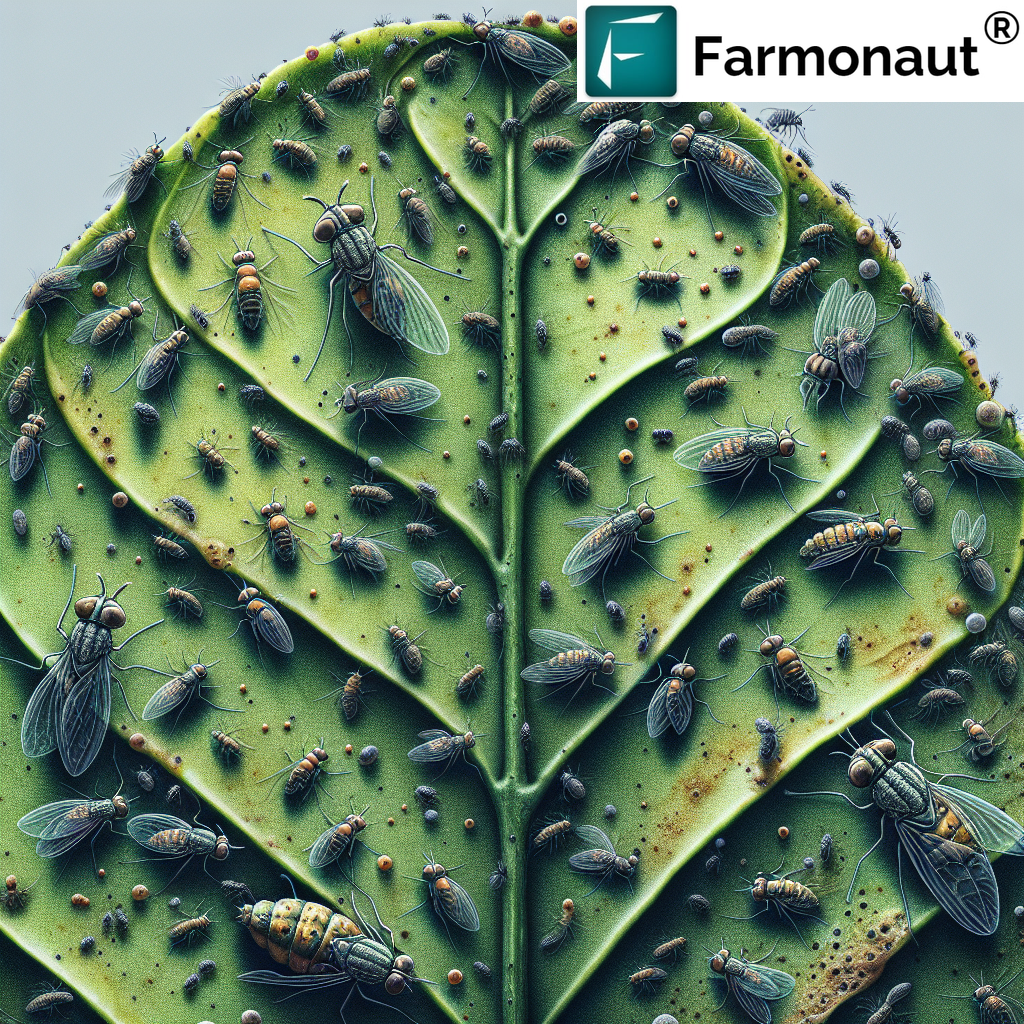Mastering Citrus Black Fly Control: A Comprehensive Guide to Protecting Your Orchard

Welcome to our comprehensive guide on managing one of the most persistent pests in citrus orchards – the citrus black fly. As experts in agricultural technology and pest management, we at Farmonaut understand the challenges that citrus growers face when dealing with this troublesome insect. In this extensive blog post, we’ll delve deep into the world of citrus black fly control, with a special focus on chemical control methods that have proven effective in protecting citrus crops.
Understanding the Citrus Black Fly
Before we dive into control strategies, it’s crucial to understand our adversary. The citrus black fly (Aleurocanthus woglumi) is a small, winged insect that poses a significant threat to citrus orchards worldwide. These pests feed on the underside of citrus leaves, causing damage that can lead to reduced fruit yield and quality.
- Appearance: Adult citrus black flies are small (about 1.5 mm long) with dark blue-black wings.
- Life Cycle: They undergo several stages – egg, nymph (or larva), pupa, and adult.
- Damage: They secrete honeydew, which promotes the growth of sooty mold on leaves and fruit.
The Impact of Citrus Black Fly on Citrus Production
The citrus black fly can have devastating effects on citrus orchards if left unchecked. Here’s why it’s crucial to implement effective control measures:
- Reduced Photosynthesis: The sooty mold that grows on honeydew secretions can cover leaves, reducing their ability to photosynthesize.
- Decreased Fruit Quality: Infested trees may produce smaller, less flavorful fruit.
- Yield Loss: Severe infestations can lead to significant reductions in overall fruit yield.
- Economic Impact: The combination of reduced yield and quality can result in substantial economic losses for growers.
Integrated Pest Management (IPM) for Citrus Black Fly
At Farmonaut, we advocate for an Integrated Pest Management (IPM) approach to controlling citrus black fly. This strategy combines various control methods to achieve the most effective and sustainable results. The key components of an IPM strategy for citrus black fly include:
- Cultural Control
- Biological Control
- Chemical Control
- Monitoring and Early Detection
While all these components are important, in this blog post, we’ll focus primarily on chemical control strategies, as they often form a critical part of managing severe infestations.
Chemical Control Strategies for Citrus Black Fly

Chemical control remains one of the most effective methods for managing citrus black fly populations, especially when infestations are severe. However, it’s crucial to use these methods judiciously and as part of a broader IPM strategy. Here, we’ll explore various aspects of chemical control for citrus black fly:
1. Types of Insecticides Effective Against Citrus Black Fly
Several classes of insecticides have shown efficacy against citrus black fly. These include:
- Neonicotinoids: Systemic insecticides that are absorbed by the plant and affect the nervous system of feeding insects.
- Pyrethroids: Fast-acting contact insecticides that disrupt the insect’s nervous system.
- Organophosphates: Broad-spectrum insecticides that inhibit important enzymes in insects.
- Insect Growth Regulators (IGRs): Compounds that interfere with the insect’s growth and development processes.
2. Application Methods for Citrus Black Fly Chemical Control
The effectiveness of chemical control largely depends on proper application. Common methods include:
- Foliar Sprays: Direct application to the leaves, targeting the undersides where citrus black flies often reside.
- Soil Drenches: Application of systemic insecticides to the soil for uptake by the tree’s roots.
- Trunk Injections: Direct injection of insecticides into the tree’s vascular system.
- Basal Bark Sprays: Application of insecticides to the lower portion of the tree trunk.
3. Timing of Chemical Applications
Proper timing is crucial for effective citrus black fly control. Consider the following:
- Life Cycle Stages: Target applications when the majority of the population is in a vulnerable stage (usually young nymphs).
- Seasonal Patterns: Understand the seasonal patterns of citrus black fly in your region to time applications appropriately.
- Weather Conditions: Apply during favorable weather conditions to maximize efficacy and minimize drift.
4. Rotation of Active Ingredients
To prevent the development of insecticide resistance, it’s crucial to rotate between different classes of insecticides. We recommend:
- Using insecticides with different modes of action in subsequent applications.
- Following a structured rotation plan based on the specific products available in your region.
- Consulting with local agricultural extension services for guidance on effective rotation strategies.
5. Safety Considerations in Chemical Control
When implementing chemical control strategies for citrus black fly, safety should always be a top priority. Consider the following:
- Personal Protective Equipment (PPE): Always wear appropriate PPE as specified on the product label.
- Environmental Impact: Choose products with minimal impact on beneficial insects and the environment.
- Pre-Harvest Intervals: Adhere to the recommended pre-harvest intervals to ensure food safety.
- Storage and Disposal: Properly store and dispose of pesticides according to local regulations.
The Role of Technology in Citrus Black Fly Management
At Farmonaut, we believe that technology plays a crucial role in modern pest management strategies. Our satellite-based monitoring system can significantly enhance your ability to detect and manage citrus black fly infestations. Here’s how:
- Early Detection: Our high-resolution satellite imagery can help identify signs of stress in citrus trees, potentially indicating the presence of pests like citrus black fly.
- Targeted Applications: By pinpointing affected areas, you can implement more targeted and efficient chemical control measures.
- Monitoring Effectiveness: Track the effectiveness of your control measures over time using our vegetation health indices.
- Data-Driven Decision Making: Use our AI-powered insights to make informed decisions about when and where to apply chemical controls.
To learn more about how Farmonaut can revolutionize your pest management strategies, visit our Farmonaut App or explore our API services.
Comparison: Farmonaut Satellite System vs. Drone and IoT-based Farm Monitoring
| Feature | Farmonaut Satellite System | Drone-based Monitoring | IoT-based Monitoring |
|---|---|---|---|
| Coverage Area | Large scale (thousands of hectares) | Limited by flight time and regulations | Limited by sensor placement |
| Frequency of Data Collection | Regular intervals (e.g., every 3-5 days) | On-demand, weather dependent | Continuous, real-time |
| Initial Investment | Low (subscription-based) | High (equipment purchase) | Moderate to High (sensors and network) |
| Operational Complexity | Low (cloud-based platform) | High (requires trained operators) | Moderate (setup and maintenance required) |
| Data Analysis | Advanced AI and machine learning | Varies based on software used | Real-time but limited to sensor data |
| Scalability | Highly scalable | Limited by equipment and personnel | Scalable but requires additional hardware |
Best Practices for Citrus Black Fly Chemical Control
To maximize the effectiveness of your chemical control strategies for citrus black fly, consider these best practices:
- Regular Monitoring: Implement a consistent monitoring program to detect infestations early. Our Farmonaut app, available on Google Play and the App Store, can assist with this.
- Proper Calibration: Ensure that your spraying equipment is properly calibrated to deliver the correct amount of insecticide.
- Coverage: Aim for thorough coverage, especially on the undersides of leaves where citrus black flies tend to congregate.
- Weather Considerations: Apply insecticides during calm weather conditions to minimize drift and maximize effectiveness.
- Integrated Approach: Combine chemical control with other IPM strategies for the best results.
- Record Keeping: Maintain detailed records of all chemical applications, including product used, rate, date, and observed effectiveness.
- Consultation: Regularly consult with local agricultural extension services or pest management professionals for up-to-date recommendations.
The Future of Citrus Black Fly Control
As we look to the future, several promising developments are on the horizon for citrus black fly control:
- Precision Agriculture: Advanced technologies like Farmonaut’s satellite monitoring system will enable more precise and targeted pest control measures.
- Biopesticides: Research into natural, plant-based pesticides may provide new, environmentally friendly control options.
- Genetic Technologies: Developments in genetic modification may lead to citrus varieties with enhanced resistance to citrus black fly.
- AI-Driven Pest Management: Artificial intelligence will play an increasing role in predicting pest outbreaks and optimizing control strategies.
To stay at the forefront of these developments, consider integrating Farmonaut’s advanced satellite monitoring and AI-powered insights into your orchard management strategy. Our API documentation provides detailed information on how to integrate our services into your existing systems.
Conclusion
Effective management of citrus black fly is crucial for maintaining healthy, productive citrus orchards. While chemical control remains an important tool in the fight against this pest, it’s essential to use these methods as part of a broader, integrated pest management strategy. By combining advanced monitoring technologies like Farmonaut’s satellite-based system with judicious use of chemical controls and other IPM practices, citrus growers can effectively manage citrus black fly populations while minimizing environmental impact and promoting sustainable agriculture.
Remember, the key to successful citrus black fly management lies in early detection, proper identification, and timely intervention. By staying informed about the latest control strategies and leveraging cutting-edge technologies, you can protect your citrus orchard and ensure bountiful harvests for years to come.
FAQ Section
Q1: How often should I apply insecticides for citrus black fly control?
A1: The frequency of insecticide applications depends on various factors, including the severity of the infestation, the specific product used, and local environmental conditions. Generally, applications every 7-14 days during peak infestation periods may be necessary. Always follow the product label instructions and consult with local agricultural experts for specific recommendations.
Q2: Are there any organic control options for citrus black fly?
A2: Yes, there are organic options available. These include neem oil, insecticidal soaps, and certain botanical insecticides. However, these may be less effective than conventional chemical controls for severe infestations and may require more frequent applications.
Q3: How can Farmonaut’s satellite monitoring help with citrus black fly control?
A3: Farmonaut’s satellite monitoring can help detect early signs of stress in citrus trees, which may indicate pest infestations. This allows for targeted and timely interventions, potentially reducing the overall need for chemical applications and improving the effectiveness of your pest management strategy.
Q4: What are the signs of citrus black fly infestation?
A4: Signs include the presence of small, dark insects on the undersides of leaves, sticky honeydew on leaves and fruit, and the growth of sooty mold. You may also notice yellowing or wilting of leaves in severe cases.
Q5: Can citrus black fly develop resistance to insecticides?
A5: Yes, like many pests, citrus black fly can develop resistance to insecticides over time. This is why it’s crucial to rotate between different classes of insecticides and integrate non-chemical control methods into your management strategy.